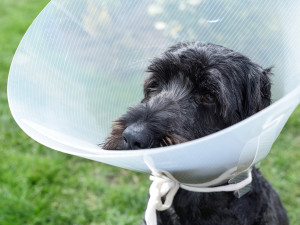How to Help Rottweilers Reach Their Senior Years
Tracking the oldest living Rottweilers.
In this Article:
Tracking the Oldest Living Dogs What Makes These Pups Live Longer? Impacts of Spay and Neuter
Both dogs and people are living longer these days — a well-reported trend. Still, not all dogs make it to their 13th year. That’s the “lucky number” for Rotts, according to researcher Dr. David J. Waters, director of the Center for Exceptional Longevity Studies at the Purdue Research Center, who pursues his work by keeping tabs on America’s oldest Rottweilers. That is, 13 in dog years, an age few Rottweilersopens in new tab attain.
Old dogs lead the way when it comes to unraveling the secrets of long life. As with their extra-old human counterparts, the question arises: What has enabled them to dodge cancer and other common or crippling diseases?
Snap a pic of your pup’s teeth, and GREENIES™ will help you spot potential signs of oral health issues.
Tracking the Oldest Living Dogs
The Murphy Foundation, which focuses on “basic, comparative and clinical research at the crossroads of cancer and aging,” is home to the Center for Exceptional Longevity Studies, the first systematic investigation of extreme longevity in dogs. The oldest dog database was established in 2005. “At that time, we had information on fewer than 25 Rotts who lived at least 13 years,” Waters says. “Now, we have collected life history data and medical records from almost 300 of these ‘centenarian Rottweilers’ from across the U.S. and Canada.” These dogs had lived 30 percent longer than expected for a breed whose lifespan averages 9.4 years.
How much do you spend on your pet per year?
Working with these senior Rottweilers has allowed Waters to observe their lifestyles and environments and interview pet parents, who filled out questionnaires about their dogs’ background and medical history, parents’ lifespans, diet — including supplement usage — and more. With each dog, Waters performed an exam and collected DNA samples. “At each stop, I’m searching for a special kind of information, finding the differences that make a difference in how we think about the process of successful aging.”
What Makes These Pups Live Longer?
These individual dogs interest Waters, but it’s no small task sorting out what makes them unique, which takes the work into the realm of epigenetics, an emerging field that is contributing to our understanding of the heredity and environment puzzle. Beyond both nature and nurture, epigenetics is the study of genetic changes (which don’t alter genetic code) yet are passed to the next generation. It’s how stress, diet, and lifestyle affect genes.
Dogs get the same cancers as humans: prostate, lung, breast, head and neck, soft tissue sarcomas, melanoma, and the bone cancer osteosarcoma, making them a good model for cancer studies in people. The treatment options are also similar: surgery, chemotherapy, and radiation. Statistics compiled by the National Cancer Institute, the American Veterinary Medical Association and the American Cancer Society are dramatic: Each year, some 6 million of the 65 million dogs in the U.S. will be diagnosed with cancer. Cancer is the major lifespan glitch, causing nearly half the deaths of dogs age ten years and over. There are also more than 11 million Americans living with cancer, and over one million new diagnoses each year.
There’s a unique opportunity with dogs to explore the gene-environment interactions that lead to the disease. Because dogs share many of the same environments and living conditions as humans, veterinary pathologists at Tufts’ Cummings School of Veterinary Medicine are studying how commonly used environmental chemicals may cause cancer in dogs.
Impacts of Spay and Neuter
Gene mapping will also help Purdue researchers unwrap the stuff that makes a Rott a Rott, and an old Rott a longevity scientist’s workhorse. The breed is prone to a particularly aggressive form of cancer, and Waters’ team thinks they may know why. Though it goes against everything vets have been advising for years, research conducted by Waters and others indicates that delaying spaying and neutering may increase the lifespan of some dog breeds. Needless to say, the work is controversial.
Waters’ work adds to the uncertainty felt by vets who are beginning to question what to tell clients about “fixing” their dogs. For one thing, there’s a higher incidence of testicular and mammary cancer in intact animals. But testicular cancer responds to castration, while castrated dogs have up to a four times greater risk of developing prostate cancer. Sterilized dogs also have a 1.5 to 3 times greater chance of developing bladder cancer.
In “Spaying, Neutering, and Cancer in Rottweilers,” veterinarian Demian Dressler discusses something he says has been “hasn’t been spread in the veterinary community.” He cites statistics included in an article in Cancer Epidemiology Biomarkers and Prevention to explain why Rotts may be vulnerable to osteosarcoma, an aggressive bone cancer common in large dogs: If a male Rott is neutered before one year of age, his risk of osteosarcoma almost quadruples. For a female Rott spayed before one year of age, the risk more than triples. (For other purebreds spayed or neutered before a year of age, the risk more than doubles.) So, those sterilized before their first birthdays had a roughly one-in-four lifetime risk for osteosarcoma and were far more likely than intact animals to develop a tumor. Dressler’s conclusion? “It’s my viewpoint that Rotts should be spayed and neutered after a year of age.”
In 2008, Waters offered a look at findings from the first 100 senior Rotts in the database in a presentation he called “Sex, Ovaries, Rock & Roll.” According to Waters, the results support the notion that how long females keep their ovaries influences how long they live.
Waters’ team found that Rottweilers spayed after age six were 4.6 times as likely to reach 13 years of age as those spayed at a younger age. Female Rottweilers normally live longer than males, a statistical norm also documented in humans. But according to Waters’ study, removing ovaries during the first four years of life erased the survival advantage.
The findings mirror those of a human study, the Nurses’ Health Study, conducted by William Parker, MD, and colleagues from the John Wayne Cancer Institute in Santa Monica, Calif. This study, which included more than 29,000 women who underwent a hysterectomy for benign uterine disease, found that the benefits of ovary removal — protection against ovarian, uterine and breast cancer — were outweighed by a higher mortality rate from other causes. Parker pointed out that for 35 years, doctors have advised women undergoing hysterectomy to have their ovaries removed to prevent ovarian cancer. According to new findings, women who retain their ovaries for at least 50 years often live longer than those who don’t.
For dogs, the comparable age for keeping the ovaries intact, at least for large breeds like Rottweilers, is about six or seven years. (On average, Waters says, the female dogs he visited had “four years of lifetime ovary exposure.”) How ovaries affect longevity in Rottweilers is not understood, but many vets agree that hormones and genetic controls play a role in cancer.
More Questions Need Answers
Waters compares sterilization to an ecosystem. Remove an element — say, caterpillars — and there are likely to be unanticipated consequences. A shorter lifespan might be one consequence of removing ovaries.
Nonetheless, Waters doesn’t recommend that people delay spaying their pets, saying that more research is needed. Not every Rottweiler benefits from keeping her ovaries. The challenge now is to identify which dogs will.
The research points to three options for pet parents of female dogs: do not spay; spay the dog after age six; or spay before puberty, which is the commonly accepted practice, and the one most vets recommend. In fact, spaying prevents two potentially fatal health problems: mammary tumors and pyometra, a serious uterine infection. It also helps with behavioral problems related to the heat cycle. And, of course, spaying helps curb overpopulation.
Waters’ work is part of a shift towards the study of healthy aging, which is more than simply long life. To that end, Waters, who is also professor and associate director of Purdue University’s Center on Aging and the Life Course, developed the first gerontology training program for vets, which teaches them how to educate pet parents on lifestyle choices.
For example, studies show that slightly underweight dogs live an average of two years longer than heavier ones. Other studies have shown that the stress hormone cortisol plays a role in triggering the growth of later-stage cancer cells. Reducing stress by addressing behavioral problems could lower the probability of cancer in some dogs.
According to Waters, the critical choices pet parents make for their pets involve diet, vaccinations, ovary removal, the use of lawn chemicals, and more. In fact, based on human-twin studies, he attributes only 30 percent of age-related health issues to genetics alone, meaning about 70 percent of longevity is attributable to non-genetic factors. “Exactly how long each individual lives is not genetically carved in stone,” Waters says. “When it comes to longevity, the lifestyle decisions we make really matter.”
Here’s the takeaway: a dog’s environment and emotions; their diet; and, yes, their lifestyle, matter greatly. How you care for your dogs can make a huge difference in the quality and length of their lives.








